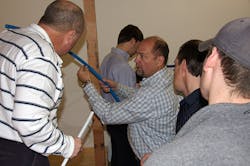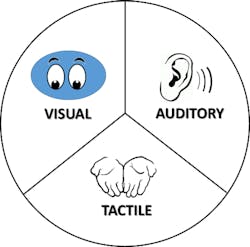Latest from Training
Sponsored
Last week, I found myself in quite a conundrum. I went to purchase new ink cartridges for my printer and they were $99.99. Sitting right next to the replacement cartridges, however, was a brand new printer complete with cartridges for $97.99.
I was faced with a modern-day technology paradox. If I pay two dollars less, I get a brand new machine with cartridges. But I don’t want the old printer to go in the landfill. And yet, if I give the old printer away because it was out of ink, the new owner would need to purchase new cartridges and they would face the same problem I was facing.
Over time, this one used printer could theoretically pass to dozens of new owners, each faced with the same dilemma. The other option was to pay the “technology hostage fee” of two dollars and keep my old printer.
Sometimes I get the feeling we are swimming upstream in a whirlpool of theoretical advances, waiting for the next final invention to flush the whole thing down the drain. And yet, I cannot deny the really positive influences of many new technologies.
Computer chips can do everything, from balancing your check book to parking your car without you even having to touch the steering wheel. And advancements in medicine, science and agriculture are extending our lives and increasing our quality of life beyond what our ancestors could ever imagine. We have bigger houses and safer cars using smaller carbon footprints and reducing energy consumption.
Some of these advancements are game-changers in their respective industries. As an example, the water-saving technologies in the plumbing industry are working so well that the United States is using less water than it did in 1970 despite a 13 percent increase in population.
And no one is likely to deny that modulating-condensing boilers have revolutionized the hydronics industry. Their ability to save energy not only saves money and precious natural resources, but also allows for a much more comfortable heat that is consistent and changes automatically to the outside temperature. The trade-off is the equipment is more technologically complicated than the previous non-condensing boiler, so it installs differently and you troubleshoot it differently.
So there is a self-evident need to stay ahead of technology. Probably the most compelling reason is that each new technology automatically triggers a new skill demand in a world already suffering from a serious shortage of skills. Additionally, each new piece of technology brings with it a learning curve that you must climb to take advantage of the benefits of the new technology.
Having said that, taking advantage of new technology can translate directly into money in your pocket. Simply put, if you aren’t making time for learning, you are missing a great opportunity to improve your financial position. And keeping up with technology is not only a potential money-maker; it is also a business survival tool. You can bet your bottom dollar that your best competitors are keeping up with technology. And they are going to use that technology on their next quote that could potentially knock you out of the bid process.
So let’s look at some options for training for new technology. As you can imagine, there are numerous ways to learn something new, and every method has merit to some degree. So rather than choose one, I suggest presenting a unified approach to training, using many different methods available.
Instead of developing a training plan, develop a training “culture.” This refers to the cumulative deposit of knowledge, experience, attitudes and learning styles of all employees, so there is a company-wide increase in technical skill — one that surrounds employees with learning options that match their learning styles. This is much more effective than having the one-off, “talking head” training every six months; or worse, expecting employees to learn on their own, simply by reading a set of instructions.
As far as a training culture is concerned, a rising tide lifts all boats.
Learning styles
I have heard from several business owners and managers that when they have tried to bring training into their shops, it’s not effective because the employees are just not learners. But this same group of employees can come into the shop on Monday and quote football statistics from Sunday’s game that stagger the imagination.
They learned a whole boat-load of new material and can reference it at will, making predictions and troubleshooting the whole entire game play by play. And they remember it a month later when they rehash the other games of the month. And you’re saying “they can’t learn?” Some of the very best technicians and installers I have known are people who don’t, by nature, like to learn in the traditional way. But they have learned their trade very well — they have just learned it in their own way.
The key to learning is finding the right style for your staff. There are three major learning styles — visual, auditory and tactile. You and your employees will fall fairly evenly into these three categories. Each style learns differently; not better or not worse, just differently. Serving up technical training in a way that meets individuals’ learning styles will help them to grow in knowledge and skill.
Let’s examine each learning style.
Visual – Visual learners learn by seeing. They can learn very easily from a book. Demonstrations or videos also work well for visual learners. Slides, photos, movies, graphics or visual organizers work well too. Visual learners are usually, but not always, the ones who take a lot of notes. Reading and writing are their preferred way of expressing their thoughts. Their difficulties come from when you ask them to wire up a new control without first seeing it done or reading the installation instructions. For visual learners, seeing comes before learning happens.
Auditory – Audio learners learn by hearing. Lectures work terrific. Audio tapes, discussions about how to do a particular control, and dialogues with others work great as well. And audio learners especially like webinars. Their difficulty will come when you ask them, for example, to read a set of instructions and expect them to know how to install a piece of equipment. Talk them through it first, then have them install the equipment. Taking timed tests that must be read and written is also challenging for audio learners. For these learners, hearing comes before learning happens.
Tactile – Tactile learners learn by touch and feel. These are the learners who have excellent motor skills and can put stuff together very well. You can always tell the tactile learners in a teaching environment — they will be the ones who are always fidgeting with something while they are learning. They are not known for note-taking, typically.Give them some pipe cleaners to fidget with during your next lecture class and their learning will greatly increase (and you will be amazed at the dazzling creations they can make out of a few pipe-cleaners).
Tactile learners don’t like sitting in one place for a long time, either. And they may have some difficulty recalling what they have seen or heard, so it is important for them to have some hands-on experience if you want them to learn. The good news about tactile learners is that if you give them a bunch of parts, they can intuitively put them together. The bad news is that they might not always know why it works. They make great installers, but may have difficulty troubleshooting. For tactile learners, touching or handling comes before learning happens.
Here is Part 2 of Steve Swanon’s article about training for new technologies, including how to incorporate different learning styles into your training sessions, and what to do regarding training fears.
Steve Swanson is the customer trainer at Uponor Academy. He can be reached at [email protected].




